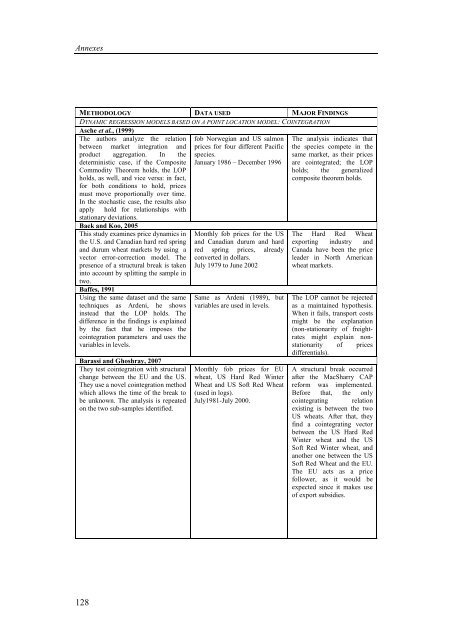TESTING INTERNATIONAL PRICE TRANSMISSION UNDER ...
TESTING INTERNATIONAL PRICE TRANSMISSION UNDER ...
TESTING INTERNATIONAL PRICE TRANSMISSION UNDER ...
Create successful ePaper yourself
Turn your PDF publications into a flip-book with our unique Google optimized e-Paper software.
Annexes<br />
METHODOLOGY DATA USED MAJOR FINDINGS<br />
DYNAMIC REGRESSION MODELS BASED ON A POINT LOCATION MODEL: COINTEGRATION<br />
Asche et al., (1999)<br />
The authors analyze the relation<br />
between market integration and<br />
product aggregation. In the<br />
deterministic case, if the Composite<br />
Commodity Theorem holds, the LOP<br />
holds, as well, and vice versa: in fact,<br />
for both conditions to hold, prices<br />
must move proportionally over time.<br />
In the stochastic case, the results also<br />
apply hold for relationships with<br />
stationary deviations.<br />
Baek and Koo, 2005<br />
This study examines price dynamics in<br />
the U.S. and Canadian hard red spring<br />
and durum wheat markets by using a<br />
vector error-correction model. The<br />
presence of a structural break is taken<br />
into account by splitting the sample in<br />
two.<br />
Baffes, 1991<br />
Using the same dataset and the same<br />
techniques as Ardeni, he shows<br />
instead that the LOP holds. The<br />
difference in the findings is explained<br />
by the fact that he imposes the<br />
cointegration parameters and uses the<br />
variables in levels.<br />
Barassi and Ghoshray, 2007<br />
They test cointegration with structural<br />
change between the EU and the US.<br />
They use a novel cointegration method<br />
which allows the time of the break to<br />
be unknown. The analysis is repeated<br />
on the two sub-samples identified.<br />
128<br />
fob Norwegian and US salmon<br />
prices for four different Pacific<br />
species.<br />
January 1986 – December 1996<br />
Monthly fob prices for the US<br />
and Canadian durum and hard<br />
red spring prices, already<br />
converted in dollars.<br />
July 1979 to June 2002<br />
Same as Ardeni (1989), but<br />
variables are used in levels.<br />
Monthly fob prices for EU<br />
wheat, US Hard Red Winter<br />
Wheat and US Soft Red Wheat<br />
(used in logs).<br />
July1981-July 2000.<br />
The analysis indicates that<br />
the species compete in the<br />
same market, as their prices<br />
are cointegrated; the LOP<br />
holds; the generalized<br />
composite theorem holds.<br />
The Hard Red Wheat<br />
exporting industry and<br />
Canada have been the price<br />
leader in North American<br />
wheat markets.<br />
The LOP cannot be rejected<br />
as a maintained hypothesis.<br />
When it fails, transport costs<br />
might be the explanation<br />
(non-stationarity of freightrates<br />
might explain nonstationarity<br />
of prices<br />
differentials).<br />
A structural break occurred<br />
after the MacSharry CAP<br />
reform was implemented.<br />
Before that, the only<br />
cointegrating relation<br />
existing is between the two<br />
US wheats. After that, they<br />
find a cointegrating vector<br />
between the US Hard Red<br />
Winter wheat and the US<br />
Soft Red Winter wheat, and<br />
another one between the US<br />
Soft Red Wheat and the EU.<br />
The EU acts as a price<br />
follower, as it would be<br />
expected since it makes use<br />
of export subsidies.
















